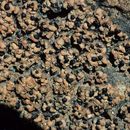en
names in breadcrumbs


Squamules: up to 4 mm wide, rounded to elongate, adnate or ascending near the margin, rarely imbricate, weakly concave to plane; upper surface: medium brown to dark brown, dull, epruinose or faintly pruinose, smooth to sparingly fissured; margin: concolorous with upper side, straight to weakly up-turned, entire or lobed; upper cortex: up to 200 μm thick, composed of rather thin-walled hyphae with more or less round lumina, not containing crystals of lichen substances, sometimes containing calcium oxalate (mainly in the epinecral layer); medulla: not containing lichen substances or calcium oxalate; lower cortex: of mainly periclinally oriented hyphae, not containing calcium oxalate; lower surface: pale to medium brown, K-; Apothecia: up to 1.5 mm diam., laminal, convex and immarginate even when young, (medium-) dark brown to black, epruinose; ascospores: 9-14 x 5-7 μm; Pycnidia: laminal, immersed; conidia: bacilliform, 6-9 x c. 1 μm; Spot tests: upper cortex and medulla K-, C-, KC-, P-; Secondary metabolites: none.
The species is sometimes difficult to distinguish from P. globifera and P. tuckermanii. It differs from the former in its often smaller and more closely adnate squamules with a more smooth, dull, and paler brown upper surface, and in having more thin-walled hyphae with more rounded lumina in the upper cortex. The stainable layer of the upper cortex is roughly 10-15 cells thick in P. globifera and 15-25 cells thick in P. luridella. The apothecia of P. luridella are dark brown to pure black, rarely medium brown, and always epruinose; those of P. globifera are medium to dark brown, rarely black, and sometimes yellow pruinose. Psora tuckermanii differs morphologically in having generally larger, usually somewhat paler and more pruinose squamules and medium brown, sometimes white or yellow pruinose apothecia. Furthermore, it usually contains calcium oxalate in the medulla.
Western North America.
On soil and rock, mainly in deserts.
Psora globifera, Psora tuckermanii.